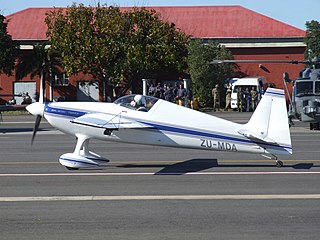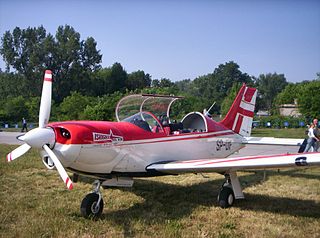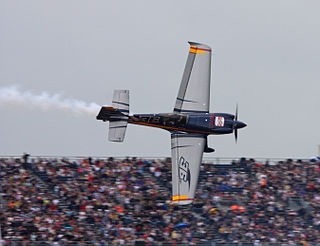
The Slick Aircraft Slick 360 is a South African aerobatics aircraft produced by the Slick Aircraft Company of Pretoria, South Africa. It is designed exclusively as an aerobatic competition aircraft, to compete in events such as the Advanced World Aerobatics Championships (AWAC).

The Zivko Edge 540 manufactured by Zivko Aeronautics is a highly aerobatic aircraft. Capable of a 420 degree per second roll rate and a 3,700 foot per minute climb rate, it has been flown to victory on the international Unlimited aerobatics circuit several times since the mid-1990s. A tandem-seat version is sold as the Edge 540T.

The Extra Flugzeugbau EA300 is a two-seat aerobatic monoplane capable of Unlimited category competition. It was designed in 1987 by Walter Extra, a German aerobatic pilot, and built by Extra Flugzeugbau.

The CAP Aviation CAP-23x family is a family of aircraft designed for competition aerobatics. The CAP 230 airframe was a direct development of the CAP 21 competition single seater strengthened to cope with a 300 hp (220 kW) 6-cylinder Lycoming AEIO-540 engine instead of the 200 hp (150 kW) original 4-cylinder Lycoming AEIO-360.

The Pitts Special is a series of light aerobatic biplanes designed by Curtis Pitts. It has accumulated many competition wins since its first flight in 1944. The Pitts biplanes dominated world aerobatic competition in the 1960s and 1970s and, even today, remain potent competition aircraft in the lower categories.

The Beechcraft Musketeer is a family of single-engined, low-wing, light aircraft that was produced by Beechcraft. The line includes the Model 19 Musketeer Sport, the Model 23 Musketeer, Custom and Sundowner, the Model 23-24 Musketeer Super III the retractable gear Model 24-R Sierra and the military CT-134 Musketeer.

The Zlin Z-50 is an aerobatic sports airplane built by the Czechoslovakian company Zlin Aircraft.

The American Champion 8KCAB Decathlon and Super Decathlon are two-seat fixed conventional gear light airplanes designed for flight training and personal use and capable of sustaining aerobatic stresses between +6g and −5g. The Decathlon entered production in the United States in 1970 as a more powerful and stronger complement to the American Champion Citabria line of aircraft.

The Slingsby T67 Firefly, originally produced as the Fournier RF-6, is a two-seat aerobatic training aircraft, built by Slingsby Aviation in Kirkbymoorside, Yorkshire, England.

PZL M26 Iskierka or M26 Airwolf is a Polish trainer and aerobatic aircraft, designed at WSK PZL-Mielec.

The AS/SA 202 Bravo is a two to three-seat civil light aircraft jointly designed and manufactured by the Swiss company Flug- und Fahrzeugwerke Altenrhein (FFA) and the Italian company Savoia-Marchetti. The aircraft was designated the AS 202 in Switzerland, and the SA 202 in Italy.

The Christen Eagle, which later became the Aviat Eagle in the mid-1990s, is an aerobatic sporting biplane aircraft that has been produced in the United States since the late 1970s.

The Extra 230 was a single-seat aerobatic aircraft developed in Germany in the early 1980s. Designed by aerobatic pilot Walter Extra based on the layout of the Laser 200 he was previously flying, the Extra 230 was a conventional mid-wing cantilever monoplane with fixed tailwheel undercarriage and a wire-braced empennage. The fuselage and empennage were of steel tube construction, but the wings were wooden. Production continued until 1990, at which time it was replaced by the Extra 300

The MXS is a single-seat aerobatic aircraft made of carbon fiber and built by MX Aircraft Company, a manufacturer located at Jandakot Airport in Perth, Western Australia. The MXS-R is a race variant flown by several pilots in the Red Bull Air Race World Championship. The planes are all-composite in construction, piston-powered, low-wing monoplanes. They are produced both in kit form for amateur construction, and completed ready to fly at the factory.
The Jurca MJ-51 Sperocco is a plans-built two-seat tandem aerobatic aircraft derived from the Jurca MJ-5 Sirocco.
The Stephens Akro is a single engine monoplane designed in the United States for aerobatic competitions. It first flew in 1967 and proved very successful, leading to several developments of which one won seven US Championships and one World Championship between 1975 and 1982. The Extra EA-230 and Extra EA-300 were also Akro developments with over two hundred built.
The Rihn DR-109 is an American aerobatic homebuilt aircraft that was designed by Dan Rihn. The aircraft was supplied by Jim Kimball Enterprises of Zellwood, Florida and more recently by Ashcraft Aero Works of Aurora, Illinois in the form of plans. It was designed for competition aerobatics as well as a trainer for the Rihn DR-107 One Design.
The Giles G-200 is an American aerobatic homebuilt aircraft that was produced by AkroTech Aviation of Scappoose, Oregon. When it was available the aircraft was supplied as a complete ready-to-fly-aircraft or a kit for amateur construction. The first customer-built aircraft made its first flight on May 26, 1996. AkroTech Aviation went out of business and the design is no longer in production.
The Tech Aero TR 200 is a French homebuilt aerobatic aircraft that was designed and produced by Tech Aero of Glisolles, first flown in August 1988. When it was available the aircraft was supplied as a kit for amateur construction.

The Extra EA-260 is a hand-built, single-seat aerobatic aircraft derived from the Extra 230 and first flown in 1986. Designed by aerobatic pilot Walter Extra based on the layout of the Extra 230, the Extra 260 is a higher performance version of its predecessor with 60% more power and 18% increase in weight. The first EA-260 was flown by Patty Wagstaff to victory in two U.S. National Aerobatic Championships, in 1991 and 1992, and then retired to the Smithsonian Institution when she obtained an Extra 300S.















